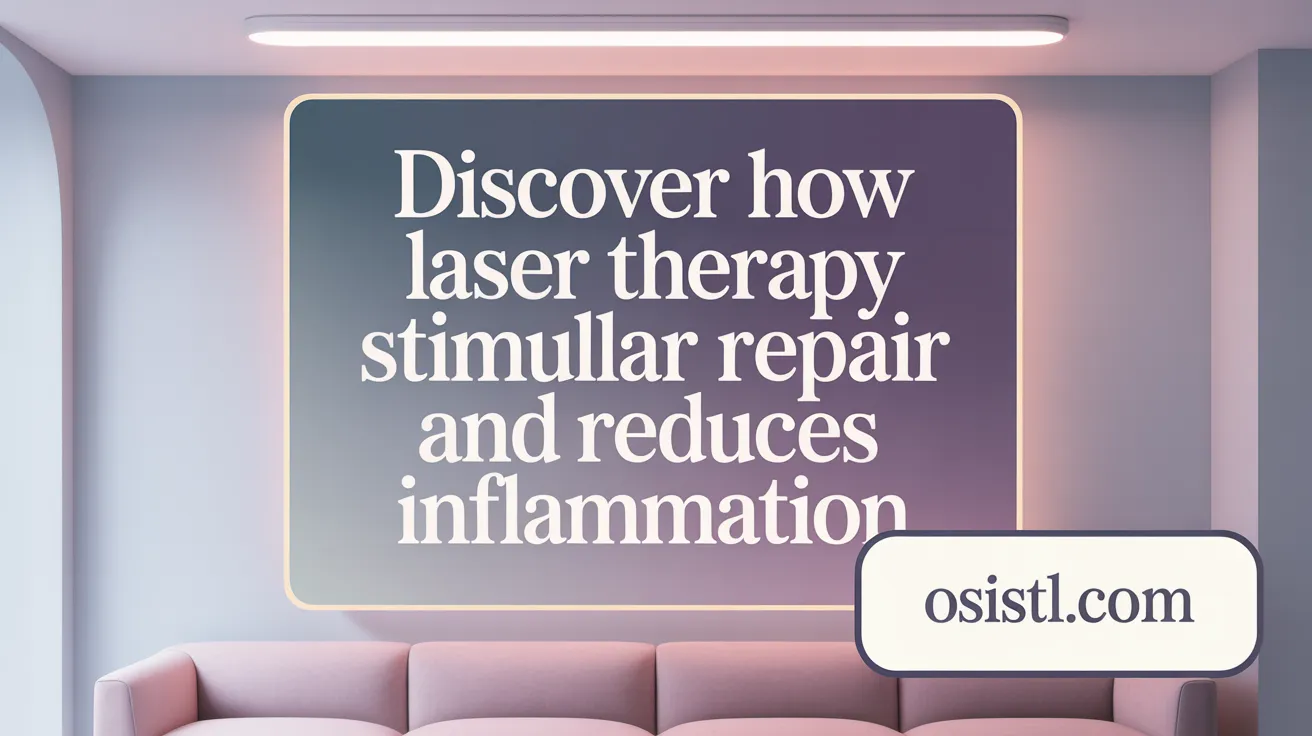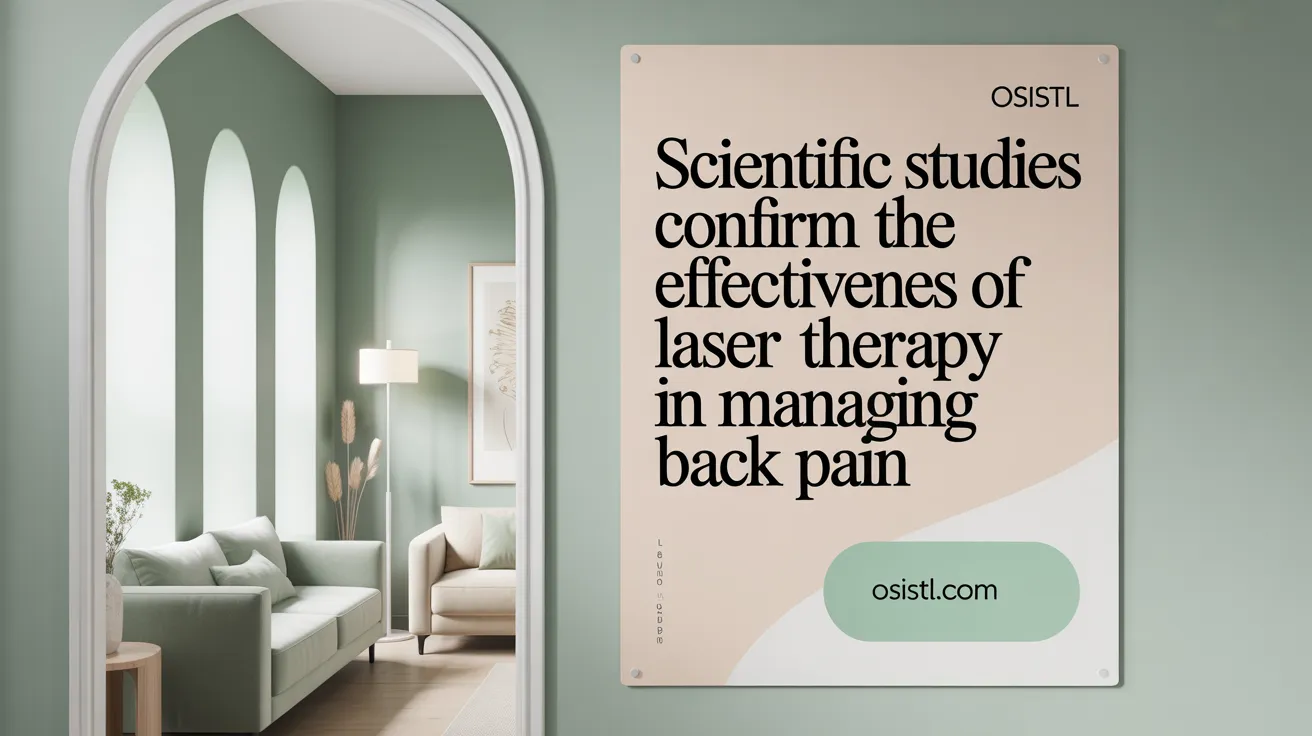Introduction to Laser Therapy for Back Pain
Overview of Laser Therapy as a Treatment for Back Pain
Laser therapy is an innovative, non-invasive treatment designed to reduce pain and accelerate healing in patients suffering from back pain. It uses specific wavelengths of light to stimulate cellular activity, which helps to promote natural tissue repair and reduce inflammation. This therapy is becoming popular as a conservative option for those experiencing conditions like chronic low back pain, herniated discs, arthritis, and sciatica.
Types of Laser Therapies Used in Pain Management
There are two main types of laser therapies commonly used for back pain:
-
Low-Level Laser Therapy (LLLT), also known as cold laser therapy, uses lower power lasers that penetrate superficial tissues to decrease inflammation and stimulate cellular repair. Typically, wavelengths such as 635 nm are used, which promote healing without heating the tissues.
-
Class 4 Laser Therapy uses higher power lasers that penetrate deeper into tissues to treat more severe pain and conditions involving deeper structures like muscles, ligaments, and nerves. These lasers can reduce nerve sensitivity and trigger the release of endorphins, providing effective pain relief.
Basic Principles of Laser Interaction with Tissues
Laser therapy works through a process called photobiomodulation. This involves the absorption of light energy by cells, especially the mitochondria, which increases production of ATP—the cellular energy currency helping cells to repair and regenerate.
The therapy also improves blood circulation to the affected area, removing waste products and delivering nutrients essential for tissue healing. Additionally, it reduces inflammation and nerve sensitivity, contributing to decreased pain and improved mobility.
Together, these effects make laser therapy a promising treatment option for patients seeking relief from back pain without surgery or medications.
Understanding the Mechanisms of Laser Therapy

How does laser therapy promote back pain relief at a cellular level?
Laser therapy works through a process called photobiomodulation, where specific wavelengths of light penetrate tissues and stimulate cellular activity. This light energy increases the production of adenosine triphosphate (ATP) in mitochondria, the energy currency of cells. Elevated ATP levels enhance cellular metabolism, promoting quicker tissue repair and regeneration.
Beyond energy production, laser therapy reduces inflammation by modulating inflammatory mediators and improving microcirculation. This enhanced blood flow delivers oxygen and nutrients to damaged tissues while removing metabolic waste, accelerating healing. Additionally, laser therapy decreases nerve sensitivity and stimulates the release of natural pain-relieving substances like endorphins as studied in the context of High-intensity laser therapy (HILT).
Different wavelengths and their therapeutic roles
Various wavelengths correspond to different therapeutic effects:
- 650 nm: Targets superficial tissues, aiding surface-level inflammation and pain. See more about 650 nm laser therapy.
- 810 nm and 915 nm: Penetrate deeper to stimulate ATP production, immune activation, and tissue healing. Related info on 810 nm laser therapy and 915 nm laser therapy.
- 980 nm: Primarily enhances circulation to facilitate tissue recovery and reduce swelling. Learn about 980 nm laser therapy.
Class 4 laser therapy uses higher power outputs enabling deeper tissue penetration, making it effective for complex musculoskeletal and neuropathic pain conditions. By selecting appropriate wavelengths, therapy can be tailored to the patient’s specific needs, enhancing outcomes.
This multi-faceted cellular stimulation laser therapy underpins the reduction of back pain, improved function, and inflammation control seen with laser therapy, making it a valuable component in comprehensive pain management plans.
Types of Laser Therapies Used in Back Pain Treatment

What are the differences between low-level and Class 4 laser therapies?
Low-level laser therapy (LLLT), often called cold laser therapy, operates at a lower power output typically below 500 milliwatts. It primarily benefits superficial tissues and induces healing through photobiomodulation without generating heat. LLLT is commonly used to alleviate conditions like chronic low back pain, rheumatoid arthritis, and osteoarthritis, with a gentle approach that is painless and non-invasive.
In contrast, Class 4 laser therapy delivers higher power output lasers capable of penetrating deeper into tissues. This makes it effective for treating chronic, acute, and deep-seated musculoskeletal issues, such as degenerative arthritis, neuropathic pain, and sports injuries. Class 4 lasers stimulate cellular activity more intensely, accelerating tissue repair, reducing inflammation, and increasing circulation. They also help alleviate nerve sensitivity through endorphin release, making them suitable for complex pain management. For more on the High-intensity laser therapy (HILT) effects, see that resource.
What are the applications and strengths of each laser type?
LLLT is well-suited for mild to moderate pain and inflammation near the skin's surface, improving function and reducing symptoms in soft tissue and joint ailments. It is advantageous for patients looking for a painless, drug-free option and is often integrated into comprehensive treatment plans including physical therapy.
Class 4 laser therapy extends benefits deeper, reaching muscles, nerves, and cartilage. It's particularly useful in neuropathy management and advanced musculoskeletal disorders where deeper penetration aids in nerve regeneration and enhanced tissue healing. Patients often experience quicker symptom relief and improved mobility after only a few sessions. You can also find insights on minimally invasive spine surgeries with laser therapy integration and long-term outcomes of laser therapy in back pain.
What are the safety profiles and patient experiences?
Both therapies are non-invasive with excellent safety records. LLLT is virtually free of side effects and does not produce heat, posing minimal risk. Class 4 lasers, while more powerful, remain safe due to controlled application, with patients typically reporting a soothing warmth during treatment sessions.
Many patients appreciate the convenience of outpatient procedures with no downtime. Treatments last between 5 and 30 minutes depending on the technology and condition treated. Laser therapy often complements other conservative approaches, offering a promising alternative to pharmacological pain management.
| Feature | Low-Level Laser Therapy (LLLT) | Class 4 Laser Therapy | Patient Experience |
|---|---|---|---|
| Power Output | Below 500 milliwatts | Above 500 milliwatts | Painless; LLLT no heat; Class 4 heat sensation |
| Tissue Penetration | Superficial | Deep tissue, muscles, nerves | Relief often after several sessions |
| Applications | Soft tissue pain, arthritis (LLLT in rheumatic diseases treatment) | Chronic musculoskeletal pain, neuropathy (neuropathy management with laser) | Non-invasive, outpatient |
| Typical Treatment Time | 5–30 minutes | 5–15 minutes | No downtime |
| Safety Profile | Very safe, minimal risks (Safety of Low-Level Laser Therapy) | Safe when properly applied (High-intensity laser therapy (HILT)) | High patient satisfaction |
Clinical Evidence Supporting Laser Therapy for Back Pain

What clinical evidence supports the use of laser therapy for back pain relief?
Clinical studies have demonstrated that laser therapy is effective in reducing pain and improving function in patients with chronic low back pain. For example, a randomized, double-blind, sham-controlled trial using the Erchonia FX 635 low-level laser therapy (LLLT) system showed that 72.4% of participants experienced significant pain relief compared to 27.6% in the control group. Remarkably, these benefits persisted for up to 12 months, with patients maintaining reduced pain and disability.
Class 4 laser therapy, which delivers higher power for deeper tissue penetration, has also been validated in multiple trials. It has been shown to decrease pain intensity, improve lumbar range of motion, and enhance functional outcomes in chronic neck and knee pain conditions. These effects are attributed to laser-induced stimulation of cellular activity, increased circulation, and reduced inflammation.
Summaries of key scientific studies on laser efficacy
- Erchonia FX 635 LLLT System: Provided pain relief in chronic low back pain with sustained benefits at one year.
- Class 4 Laser Therapy Studies: Demonstrated reduced pain and improved motion in degenerative and neuropathic pain conditions.
- High-intensity laser therapy (HILT) effects: Showed analgesic, anti-inflammatory, and microcirculation benefits along with improved function.
- Multimodal Clinical Trials: Combined laser therapy with exercises and physical therapy, leading to enhanced recovery and reduced disability.
Evidence of pain reduction, inflammation control, and functional improvement
Laser therapy works through photobiomodulation, enhancing ATP production and cellular repair. This translates clinically into:
- Significant pain reduction, including neuropathic pain symptoms like numbness and burning.
- Decreased tissue inflammation and swelling.
- Enhanced blood flow promoting healing.
- Improved functional ability and range of motion in spine and joint conditions.
Long-term outcomes and patient satisfaction
Patients receiving laser therapy report durable pain relief and improved quality of life. Studies show high satisfaction rates due to the noninvasive, painless nature of treatment and lack of major side effects. The enduring improvement in function supports long-term outcomes of laser therapy in back pain as a viable adjunct or alternative to traditional pharmacologic and surgical interventions for back pain management.
Applications and Benefits of Laser Therapy in Various Back Pain Conditions

For which types of back pain conditions is laser therapy especially beneficial?
Laser therapy offers effective relief for several common and challenging back pain conditions. It is particularly beneficial for sciatica, where nerve compression causes leg pain and numbness, degenerative disc disease marked by the breakdown of spinal discs, and spinal stenosis involving nerve space narrowing. Neuropathic pain symptoms like burning, tingling, and numbness also respond well to laser treatments, which stimulate nerve function improvement. Muscle strains and overuse injuries further benefit from laser therapy's pain reduction and tissue healing effects.
How does laser therapy fit within broader back pain treatment plans?
A major advantage of laser therapy is its non-invasive nature. This painless treatment penetrates deep tissues to promote healing, reduce inflammation, and relieve pain without surgery or drugs. Because of its safety and efficacy, laser therapy is often integrated into multidisciplinary care programs, complementing physical therapy, exercise, manual therapies, and medication management. Patients typically undergo a series of sessions (commonly 8 or more) where controlled laser light targets affected areas, stimulating cellular repair and increasing circulation (photobiomodulation benefits.
Who is a good candidate for laser therapy and what does treatment look like?
Laser therapy is especially suitable for patients with mild to moderate chronic back pain, those who prefer to avoid surgical options, and individuals looking for adjuncts to traditional rehabilitation. Typical protocols involve multiple outpatient sessions lasting 5-30 minutes depending on the device and condition, with treatments customized to the patient's specific diagnosis and response. The therapy is well-tolerated, with no downtime, allowing patients to resume normal activities immediately after sessions (non-invasive pain treatment.
In sum, laser therapy is a versatile and valuable tool in managing various back conditions by fostering natural healing and offering an alternative or complement to conventional treatments.
Laser Therapy in Practice: Procedures and Patient Experience
What can patients expect during a laser therapy session for back pain?
Patients typically receive laser therapy for pain relief as a painless outpatient treatment lasting between 5 and 30 minutes, depending on the device and condition treated. During the session, a clinician positions the laser device—often with adjustable arms—over the painful or injured area. The treatment involves controlled bursts of laser energy targeting tissues beneath the skin without causing heat or discomfort.
Typical laser therapy session protocols and duration
Most protocols require multiple sessions, usually at least 8, to achieve meaningful pain reduction and functional improvement. Sessions commonly last around 5 to 15 minutes for Class IV deep tissue laser therapy or up to 30 minutes for specialized systems like MLS laser therapy or low-level laser therapy (LLLT). The therapy's noninvasive nature allows patients to undergo repeated treatments without adverse effects.
Common patient sensations and safety considerations
Patients frequently report a soothing warmth or mild tingling sensation during treatment, indicating the laser’s action on tissues. The therapy is well tolerated, with no reports of significant side effects or safety concerns across extensive clinical studies on low-level laser therapy. Because the laser does not produce heat that damages tissues, it selectively stimulates cellular repair and reduces inflammation.
Integration with other treatments like physical therapy
Laser therapy is often integrated into comprehensive care plans, including physical therapy, manual techniques, exercise, and posture correction. Combining laser treatments with rehabilitative therapies enhances clinical outcomes by addressing pain, promoting healing, and improving mobility. This multidisciplinary approach suits patients seeking nonpharmacologic treatments for chronic back pain.
Innovations and Future Directions in Laser Therapy for Spine Care
How are newer laser technologies shaping the future of back pain management?
Advancements in laser therapy have brought innovative tools like Class 4 laser therapy high-intensity and MLS (Multiwave Locked System) laser therapies to the forefront of spine care. These newer lasers offer powerful, deep tissue penetration beyond the capabilities of traditional Low-Level Laser Therapy (LLLT), enabling treatment of chronic and acute conditions affecting muscles, nerves, and joints.
Class 4 lasers stimulate cellular activity and regeneration while also promoting nerve repair and reducing inflammation, contributing to improved function and pain relief. MLS laser therapy combines dual wavelengths to target pain and inflammation simultaneously, enhancing healing without discomfort or downtime.
Integration with minimally invasive spine treatments
Laser therapy is increasingly being used alongside minimally invasive spine surgeries and physical rehabilitation. Minimally invasive procedures reduce tissue damage and speed recovery, and when paired with laser treatments, patients benefit from accelerated tissue repair and anti-inflammatory effects post-surgery or during conservative care. This synergy can improve outcomes for conditions such as degenerative disc disease, herniated discs, and spinal stenosis.
Research trends and potential expanding indications
Emerging clinical evidence highlights benefits of high-intensity laser therapy for chronic low back pain, neuropathies, and arthritis-related pain, showing sustained relief and functional improvements. Ongoing research is expanding laser therapy indications beyond conventional musculoskeletal pain to include nerve regeneration and post-operative recovery support.
As the technology evolves, laser therapy is poised to become a cornerstone in personalized spine care, offering non-invasive, drug-free alternatives that integrate well with existing treatment modalities. This holistic approach is gaining traction in specialized centers and private clinics, promising broader accessibility and tailored patient-centered care.
Laser Therapy within a Comprehensive Spine Care Approach
How does laser therapy fit into the broader management of back pain at specialized spine centers?
Laser therapy is a valuable component of conservative back pain management at specialized spine centers. It is often integrated with other non-surgical treatments such as physical therapy, injections, and lifestyle modifications including posture correction and exercise. This multidisciplinary approach aims to reduce pain, inflammation, and improve tissue healing, providing relief that supports patients before considering surgical intervention.
Role of laser therapy among conservative and surgical treatments
At comprehensive spine care facilities, laser therapy complements traditional conservative treatments. Patients with conditions like degenerative disc disease, herniated discs, or arthritis may undergo laser therapy to reduce nerve sensitivity, enhance circulation, and stimulate cellular repair. If conservative management including laser therapy is insufficient, minimally invasive surgical options such as microdiscectomy or spinal fusion are tailored to the patient's needs. Additionally, there is growing evidence on the long-term outcomes of laser therapy in back pain supporting its integration in treatment plans.
Patient-centered care philosophy at spine institutes
Spine centers emphasize personalized, patient-centered care, fostering trust through clear communication and education about treatment options. Specialists collaborate across disciplines to design holistic care plans. Laser therapy is offered as part of a broad spectrum of treatments personalized to patient goals, severity of symptoms, and lifestyle factors.
Importance of individualized treatment planning and follow-up
Each patient’s spine condition requires a tailored approach, with laser therapy used according to specific clinical protocols and patient response. Regular follow-up ensures monitoring of treatment effectiveness and adjustments as needed. This individualized planning optimizes functional recovery and pain relief, integrating both conservative and surgical modalities when appropriate. Insights from high-intensity laser therapy (HILT) effects further aid in refining these plans for improved outcomes.
Conclusion: The Promise of Laser Therapy in Back Pain Relief
Laser therapy offers a promising, non-invasive option for managing back pain by stimulating the body's natural healing processes. It effectively reduces pain, inflammation, and nerve sensitivity while enhancing tissue repair and circulation.
Clinical studies support its benefits in chronic conditions such as degenerative arthritis, neuropathic pain, and sports injuries, showing improvements in pain relief and functional mobility. The therapy's ability to penetrate deep tissues, especially with Class 4 lasers, makes it suitable for more severe cases where traditional treatments may fall short.
Patients experiencing mild to moderate back pain are encouraged to discuss laser therapy with their healthcare providers. Personalized treatment plans that incorporate laser therapy alongside physical therapy or exercise can optimize pain management and recovery.
As healthcare shifts towards conservative, nonpharmacologic options for chronic pain, laser therapy is expected to play an increasingly important role. Its safety profile and long-lasting effects make it a valuable complement to comprehensive spine care, offering patients a chance to improve quality of life without surgery or medications.
